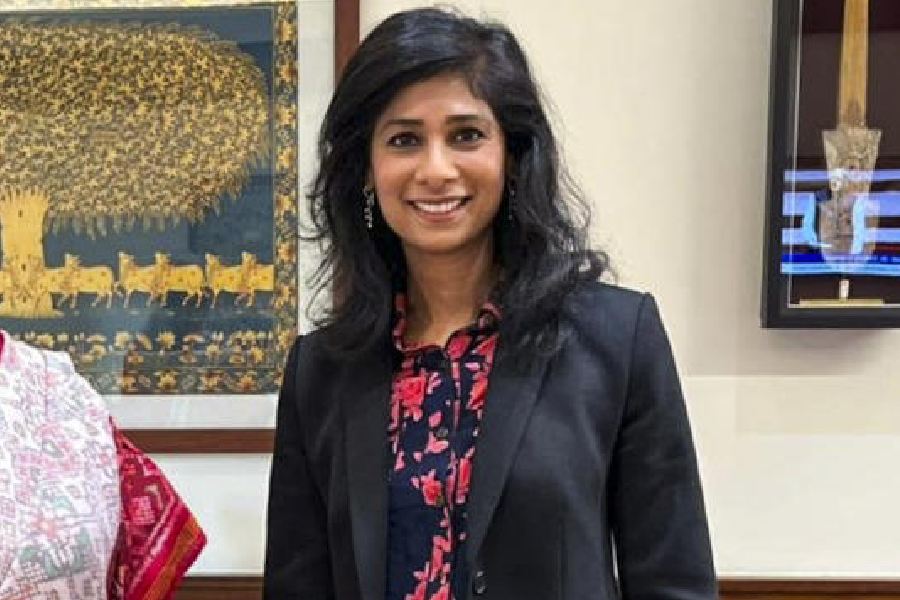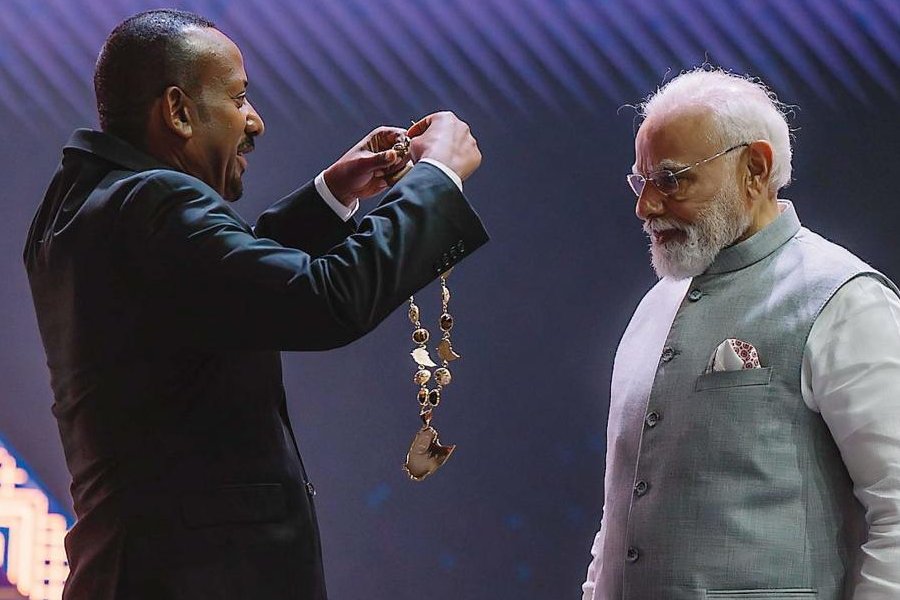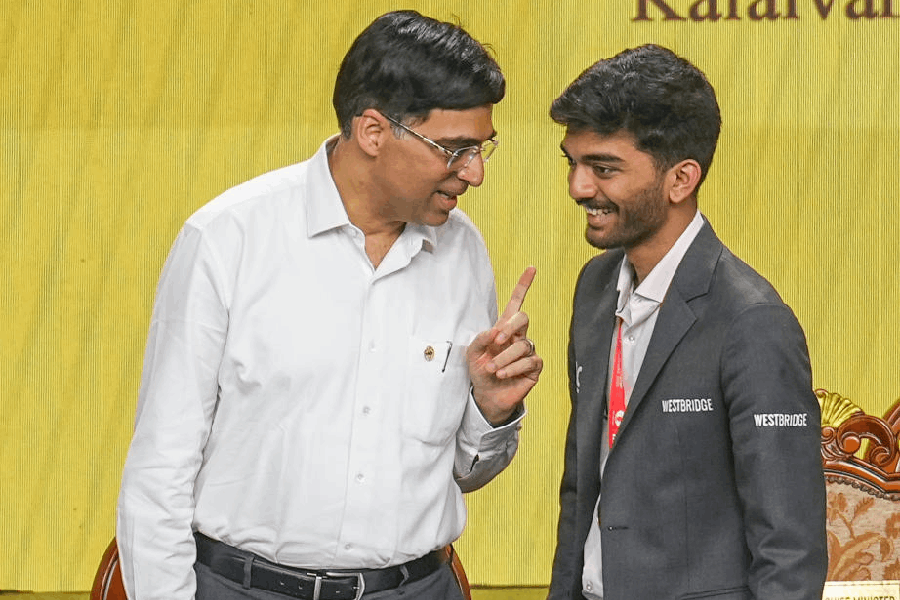 |
 |
| Paean time: Radhika Verma and Udit Sarkhel with the latters’s sketch of Tagore; (left) Sangeeta Datta |
Time for a real taste of Tagore
If food be the music of love, serve on,/Give me excess of it; that surfeiting,/The appetite may sharpen, with ilish fry. Duke Orsino, I admit, didn’t utter precisely these words in Twelfth Night, possibly because the Bard, who otherwise had a lot to say about food, wasn’t exposed to Bengali cuisine.
But since Britain is currently celebrating the 150th birth anniversary of Rabindranath Tagore — what with Amartya Sen giving a lecture at the British Museum and the director Sangeeta Datta introducing a screening of Satyajit Ray’s documentary on the poet at the British Film Institute Southbank — it was time to test the proposition that food is the carrier of culture.
Love me, love my begun bhaja, as it were.
It seems no one has really conducted research into what Tagore had to say about food or indeed what constituted Bengali cuisine in his time.
“Tagore died in 1941 and Bengali cuisine hasn’t really changed all that much over the past century,” I learn from Krishna Dutta, who is the author of a book on Calcutta and co-author, with Andrew Robinson, of an anthology of Tagore.
Sangeeta Datta recalls some Bengali food items are mentioned by Tagore in Chhelebela (My Boyhood).
The late Nirad C. Chaudhuri, who was proud of his mastery of written English, once confided to me: “I take only beef and boiled vegetables. You cannot write good English on Bengali food.”
If that is the case, Tagore must have relied on Bengali food when writing Gitanjali, which earned the Nobel Prize for literature in 1913.
One of the few master chefs capable of cooking Bengali cuisine in London is Udit Sarkhel, who used to own the Calcutta Notebook and now runs another restaurant, Mango and Silk, in East Sheen, south-west London, with his partner, Radhika Verma.
Udit can cook all the items Krishna and Sangeeta say have been part of Bengali cuisine from even before the time of Tagore — from ilish (hilsa) to luchi, aloor dom, tomato chutney, mishti doi and sandesh.
Author jointly with the BBC food journalist Simon Parkes of The Calcutta Kitchen, he declares: “I would love to cook Bengali food at the Tagore functions.”
Udit, a part-time painter who did a charcoal sketch of Tagore when he was 13, considers Bengali cuisine an art form.
What’s pleasing about Udit is that he will not lecture you about cholesterol if you ask to have a little pure ghee sprinkled over your hot rice to enhance your appreciation of Tagore.
 |
| ARTIST’S MUSE: Sue MacLaine as Henrietta Moraes |
Bohemian rhapsody
Henrietta Moraes, who seduced Dom Moraes when the budding Indian poet was an 18-year-old undergraduate at Oxford and she was 25, is the subject of an unusual new play in which the audience are invited to “bring a sketchbook and drawing materials of your choice (not charcoal)” and draw the main character on stage.
The one-woman show, Still Life: An Audience with Henrietta Moraes, written and performed by Sue MacLaine, opens today at the Phoenix Gallery, a theatre in the seaside resort of Brighton.
In the 1950s, Henrietta relished being part of the Bohemian society that made London’s Soho its headquarters. She posed for two famous artists, Francis Bacon and Lucian Freud, with whom she had affairs. She had two children by her second husband, actor Norman Bowler, though a DNA test later confirmed the biological father of one son was an English aristocrat, Colin Tennant, 3rd Baron Glenconner.
She was born Audrey Wendy Abbott in Simla, where her father was stationed in the Indian Air Force — it is unclear whether she was part Anglo-Indian — but in England, her first husband, filmmaker Michael Law, renamed her Henrietta.
When she met Dom in a Soho bar in 1956, she thought him a pretty boy and took him to bed. They were married in 1961.
But five years into their marriage, Dom said: “Darling, I’m going out for some cigarettes.”
He kept going — all the way to Bombay — to a new life and new loves (Leela Naidu, later Sarayu Srivatsa). Despite her erratic life — or possibly because of it — Henrietta was loved by her friends. She died in 1999, with one paper noting that “hers was an itinerant and rackety life, sustained by the tolerance of friends, oiled by alcohol and fuelled by an astonishing variety of drugs.”
On radio last week, artist Maggi Hambling, who drew her friend Henrietta after she had died, said: “She had 10 times more life than anybody else — a force of nature. They don’t make them like that any more.”
It hardly seems seven years have passed since Dom died. I can imagine Dom encouraging me to drive him to see the play and, after the performance, ordering a second bottle of red wine.
 |
| FACE TO FACE: Prince Charles with President Obama |
Tea for two
When Prince Charles dropped in at the Oval Office in the White House last week to have a cup of tea with President Obama, the killing of Osama was apparently not mentioned. Instead, Obama, who watched part of the Royal Wedding on television, confided that America was “mesmerised” by the spectacle.
Obama did not attend the wedding, possibly because he and his wife, Michelle, start a three-day (heavily guarded) state visit to Britain on May 24 when they will stay at Buckingham Palace.
The President described how he was impressed by William and Kate’s handling of the pressure of the big day, and joked he could not have coped with such a situation himself — he had just 300 guests at his wedding to Michelle.
William has returned to his duties as a helicopter pilot but the big news is that Kate has been photographed wheeling a trolley round her local branch of the Waitrose supermarket chain and loading the car on her own with her shopping.
Shining example
The Connaught Hotel in London has teamed up with shoemaker John Lobb to offer customers the ultimate in polished shoes — at £30 (Rs 2,207) a time, according to the latest GQ.
For that money, our local moochi in Calcutta would have dealt with 441 pairs — and done as good a job as his London equivalent, Mr Martin Binks.
Cricket coverage
The live footage available online of the IPL matches, which I have been watching on full screen, has been remarkably good in quality. The foreign commentators do know their cricket but cannot identify the glamorous women in the VVIP sections.
What is irritating, though are the ads — do Kerala “God’s own country” and Lebara mobile have to be repeated continually?
Tittle tattle
Smash and grab is clearly the sincerest form of flattery.
I say this because six men on scooters used sledgehammers to smash the window of a shop in London’s Bond Street last week and made off with 50 Anya Hindmarch designer handbags worth £45,000 from its spring/summer 2011 collection.
Police said the thieves targeted the Anya Hindmarch shop because its designer handbags were prominently carried by a number of celebrity guests at the wedding.
Among them were various royals, including the Duchess of Kent, Serena Armstrong-Jones, Lady Helen Taylor and Julia Ogilvy.
A spokeswoman for the shop said: “This is the ninth time Anya Hindmarch stores have been targeted this way.”










